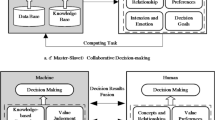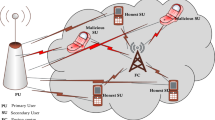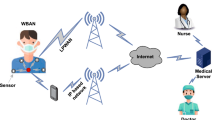Abstract
The success of mobile networks has been driven by the services offered, i.e. voice in second generation and multimedia services in third generation networks. Similarly, a key issue for the success of future generation networks is considered to be the provision of enhanced, always available, personalised services. At the same time, the complexity and heterogeneity of the infrastructure of mobile network operators increases as Radio Access Technologies continue to evolve and new ones emerge. All these issues call for self-management and learning capabilities in future generation network systems. Cognitive, reconfigurable systems encompassing self-management and learning capabilities have been devised as a solution in this direction. Cognitive systems determine their behaviour, in a self-managed way. This is done reactively or proactively, based on goals, policies, knowledge and experience obtained through learning. This paper focuses on the user device and presents a Cognitive Device Management System that comprises mechanisms for dynamically selecting the optimal device configuration, taking into account user preferences, device environment characteristics (context), policies, and knowledge established through machine learning functionality.














Similar content being viewed by others

Abbreviations
- \(\textit{B3G}\) :
-
Beyond the third generation
- \(\textit{BR}\) :
-
Bit rate
- \(\textit{CDMS}\) :
-
Cognitive device management system
- \(\textit{GUI}\) :
-
Graphical user interface
- \(\textit{JRRM}\) :
-
Joint radio resource management
- \(\textit{MADM}\) :
-
Multi-attribute decision making
- \(\textit{Mbps}\) :
-
Megabits per second
- \(\textit{MNO(s)}\) :
-
Mobile network operator(s)
- \(\textit{msecs}\) :
-
Milliseconds
- \(\textit{QoS}\) :
-
Quality of service
- \(\textit{RAT(s)}\) :
-
Radio access technology(-ies)
- \(\textit{RTT}\) :
-
Round trip time
References
Kephart, J., & Chess, D. (2003). The vision of autonomic computing. IEEE Computer, 36(1), 41–50.
Thomas, R., Friend, D., DaSilva, L., & McKenzie, A. (2006). Cognitive networks: Adaptation and learning to achieve end-to-end performance objectives. IEEE Communications Magazine, 44(12), 51–57.
FP7/ICT project \(\text{ E }^{3}\) (End-to-End Efficiency) (ICT-2007-216248) (2011), Jan 2008–Dec 2009 Website: https://ict-e3.eu/.
Wireless Innovation Forum. (2013). http://www.wirelessinnovation.org/.
Haykin, S. (2005). Cognitive radio: Brain-empowered wireless communications. IEEE Journal on Selected Areas in Communications, 23(2), 201–220.
Mitola, J. (2000). Cognitive radio: An integrated agent architecture for software defined radio. Stockholm, Sweden: Royal Institute of Technology (KTH).
Mitola, J., & Maguire, G. Q, Jr. (1999). Cognitive radio: Making software radios more personal. IEEE Personal Communications, 6(4), 13–18.
Mitchel, T. (1997). Machine learning. NY: McGraw-Hill.
Fodor, G., Furuskar, A., & Lundsjo, J. (2004). On access selection techniques in always best connected networks. In ITC specialist seminar on performance evaluation of wireless and mobile systems (pp. 89–100).
Xing, B., & Venkatasubramanian, N. (2005, July). Multi-constraint dynamic access selection in always best connected networks. In Proceedings of the second annual international conference on mobile and ubiquitous systems: Networking and services (MobiQuitous), San Diego, CA, USA.
Song, Q., & Jamalipour, A. (2005). Network selection in integrated wireless LAN and UMTS environment using mathematical modelling and computing techniques. IEEE Wireless Communications Magazine, 12(3), 42–48.
Bari, F., & Leung, V. (2007). Automated network selection in a heterogeneous wireless network environment. IEEE Network Magazine, 21(1), 34–40.
Nguyen-Vuong, Q. T., Agoulmine, N., & Ghamri-Doudane, Y. (2007). Terminal controlled mobility management in heterogeneous wireless networks. IEEE Communications Magazine, 45(4), 122–129.
Van Sinderen, M. J., Van Halteren, A. T., Wegdam, M., Meeuwissen, H. B., & Henk Eertink, E. (2006). Supporting context-aware mobile applications. IEEE Communications Magazine, 44(9), 96–104.
Gandetto, M., Cattoni, A., & Regazzoni, C. (December 2005). A distributed approach to mode identification and spectrum monitoring for cognitive radios. In Proceedings of software defined radio (SDR. 2005). Technical Conference. USA: Anaheim.
Bellavista, P., Corradi, A., Montanari, R., & Tononelli, A. (2006). Context-aware semantic discovery for next generation mobile systems. IEEE Communications Magazine, 44(9), 62–71.
Kim, H., & Shin, K. G. (2008). Efficient discovery of spectrum opportunities with MAC-layer sensing in cognitive radio networks. IEEE Transactions on Mobile Computing, 7(5), 533–545.
Demestichas, K., Koutsorodi, A., Adamopoulou, E., & Theologou, M. (2008). Modelling user preferences and configuring services in B3G devices. Journal of Wireless Networks, 14(5), 699–713.
Homayounvala, E., & Aghvami, A. H. (2005). User preference modelling for access selection in multiple radio access environments. IEICE Transactions on Communications, Special Section on Software Defined Radio Technology and Its Applications, EE88–B(11), 4186–4193.
Tsagkaris, K., Katidiotis, A., & Demestichas, P. (2008). Neural network-based learning schemes for cognitive radio systems. Computer Communications, 31(14), 3394–3404.
Demestichas, P., Katidiotis, A., Tsagkaris, K., Adamopoulou, E., & Demestichas, K. (2009). Enhancing channel estimation in cognitive radio systems by means of Bayesian networks. Wireless Personal Communications Journal, 49(1), 87–105.
Liu, X., & Shankar, N. S. (2006). Sensing-based opportunistic channel access. Mobile Networks and Applications Journal, 11(4), 577–591.
Perez-Romero, J., Sallent, O., Agusti, R., & Giupponi, L. (2007, April). A novel on-demand cognitive pilot channel enabling dynamic spectrum allocation. In Proceedings 2nd International Symposium on New Frontiers in Dynamic Spectrum Access Networks. (2007). DySPAN 2007. Ireland: Dublin.
Nolan, K., & Doyle, L. (2007). Teamwork and collaboration in cognitive wireless networks. IEEE Wireless Communications Magazine, 14(4), 22–27.
Giupponi, L., Agustí, R., Pérez-Romero, J., & Sallent, O. (2008). Fuzzy neural control for economic-driven radio resource management in beyond 3G networks. IEEE Transactions on Systems, Man, & Cybernetics, Part C, 170–189.
Perez-Romero, J., & Sallent, O. (June 2009). A novel autonomous RAT selection algorithm for non real time services. In Proceedings of the ICT Summit, Santander, Spain.
Coyle, L., & Cunningham, P. (2004). Improving recommendation ranking by learning personal feature weights. Lecture Notes in Computer Science (including subseries Lecture Notes in Artificial Intelligence and Lecture Notes in Bioinformatics), 3155, 560–572.
Zhang, Y., & Koren, J. (July 2007). Efficient Bayesian hierarchical user modeling for recommendation systems. In Proceedings of SIGIR’07, Amsterdam, The Netherlands.
Guo, Y., Müller, J. P., & Weinhardt, C. (2003). Learning user preferences for multi-attribute negotiation: An evolutionary approach. Lecture Notes in Artificial Intelligence (Subseries of Lecture Notes in Computer Science), 2691, 303–313.
Oh, J., & Smith, S. F. (2005). Learning user preferences in distributed calendar scheduling, Lecture Notes in Computer Science (including subseries Lecture Notes in Artificial Intelligence and Lecture Notes in Bioinformatics), 3616 LNCS, 3–16.
Santos, E. Jr., Brown, S., Lejter, M., Ngai, G., Banks, S., & Stytz, M. (May 1999). Dynamic user model construction with Bayesian networks for intelligent information queries. In Proceedings of the twelfth international Florida artificial intelligence research society conference, Orlando, Florida.
Krause, A., Smailagic, A., & Siewiorek, D. P. (2006). Context-aware mobile computing: Learning context- dependent personal preferences from a wearable sensor array. IEEE Transactions on Mobile Computing, 5(2), 113–127.
Chen, A. (May 2005). Context-aware collaborative filtering system: Predicting the user’s preference in the ubiquitous computing environment. In Proceedings of Workshop on Location- and Context-Awareness (LoCA 2005), Oberpfaffenhofen, Germany.
Dey, A. (2008, July). Modeling and Adding Intelligibility to Human Activity. In Proceedings of international symposium on ubiquitous virtual reality, Gwangju, Korea.
Demestichas, P., Katidiotis, A., Stavroulaki, V., & Petromanolakis, D. (2010). Management system for terminals in the wireless B3G world. Wireless Personal Communications Journal, 53(1), 81–109.
Stavroulaki, V., Kritikou, Y., & Demestichas, P. (2009, June). Acquiring and learning user information in the context of cognitive device management. In Proceedings IEEE international conference on communications 2009 (ICC 2009), Dresden, Germany.
Likert, R. (1932). A technique for the measurement of attitudes. Archives of Psychology, 22(140), 1–55.
Bolstad, W. M. (2007). Introduction to Bayesian Statistics (2nd ed.). NY: Wiley.
Stavroulaki, V., Petromanolakis, D., & Demestichas, P. (2010). Utility-aware cognitive network selections in wireless infrastructures. Wireless Personal Communications Journal, 63, 1–30.
Russell, S. J., & Norvig, P. (2002). Artificial intelligence: A modern approach. New Jersey: Prentice-Hall.
Neapolitan, R. E. (2002). Learning Bayesian networks. Englewood Cliffs, NJ: Prentice Hall.
Jensen, F. (2001). Bayesian networks and decision graphs. New York: Springer.
Bari, F., & Leung, V. (2007). Automated network selection in a heterogeneous wireless network environment. IEEE Network, 21(1), 34–40.
Koenig, W., Nolte, K., Gebert, J., Demestichas, P., Stavroulaki, V., & Saatsakis, A. (2009, September). Introducing cognitive systems in the B3G world: the E3 approach to the “invisible” network of the future. In Proceedings 20th IEEE international symposium on personal indoor mobile radio communications 2009, Tokyo, Japan.
Laboratory of Telecommunication Networks and Integrated Services (TNS), Department of Digital Systems, University of Piraeus, Greece (2011). Demonstration of Cognitive Device Management for enabling Future Internet Scenarios, http://tns.ds.unipi.gr/multi/terminals.avi.
Wikipedia contributors (2013). Stress testing. Wikipedia, The Free Encyclopedia.
FP7/ICT project OneFIT (Opportunistic networks and cognitive management systems for efficient application provision in the future interneT) (ICT-2009-257385) (2012). July 2010–December 2012, Website: http://www.ict-onefit.eu.
FP7/ICT project UniverSelf, (ICT-2009-257513) (2013). September 2010–August 2013, Website: http://www.univerself-project.eu.
Acknowledgments
This work was performed in the project E\(^{3}\) (www.ict-e3.eu) which had received research funding from the Community’s Seventh Framework programme. The contributions of colleagues from the E\(^{3}\) consortium are hereby acknowledged. This work was evolved in the context of the OneFIT (Opportunistic networks and Cognitive Management Systems for Efficient Application Provision in the Future InterneT, www.ict-onefit.eu) and UniverSelf (http://www.univerself-project.eu/) Projects. Furthermore, evolved versions of this work have supported training activities in the context of the ACROPOLIS (Advanced coexistence technologies for Radio Optimisation in Licenced and Unlicensed Spectrum -Network of Excellence) project (http://www.ict-acropolis.eu). This paper reflects only the authors’ views and the Community is not liable for any use that may be made of the information contained therein.
Author information
Authors and Affiliations
Corresponding author
Rights and permissions
About this article
Cite this article
Stavroulaki, V., Koutsouris, N., Kritikou, Y. et al. Cognitive Management of Devices in the Wireless World. Wireless Pers Commun 75, 2289–2322 (2014). https://doi.org/10.1007/s11277-013-1468-2
Published:
Issue Date:
DOI: https://doi.org/10.1007/s11277-013-1468-2



